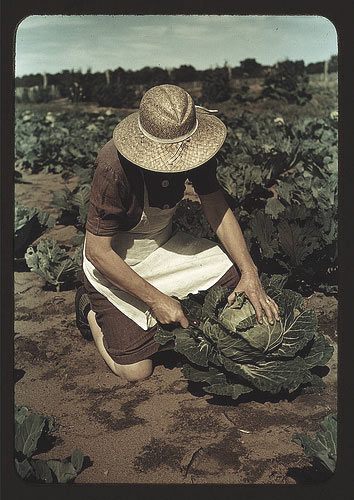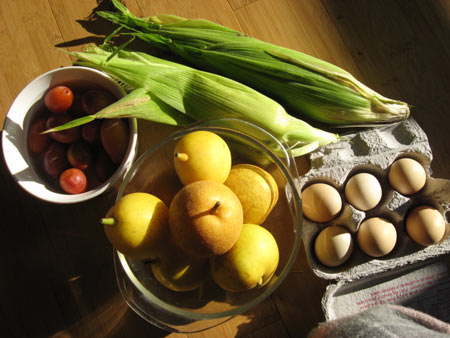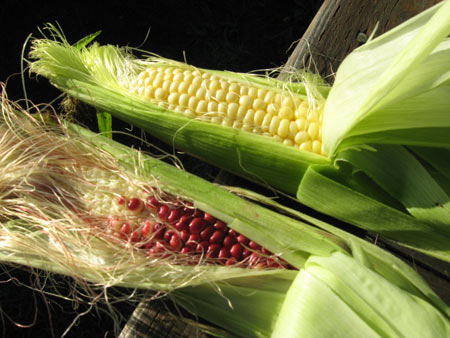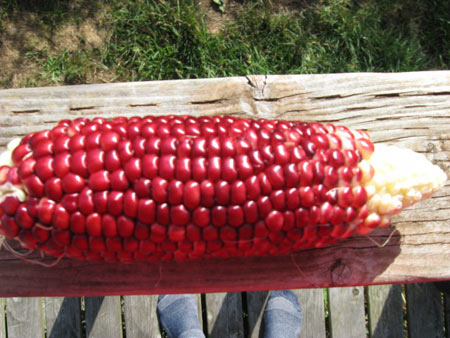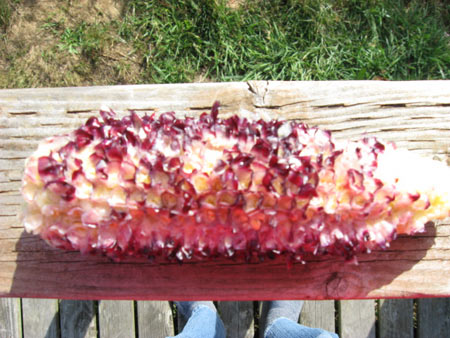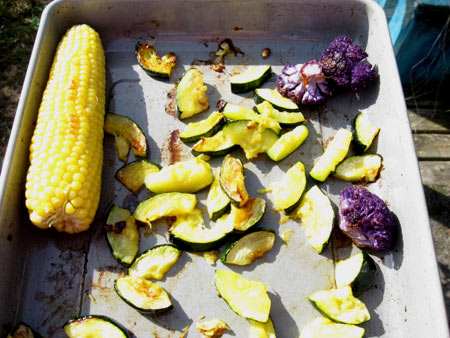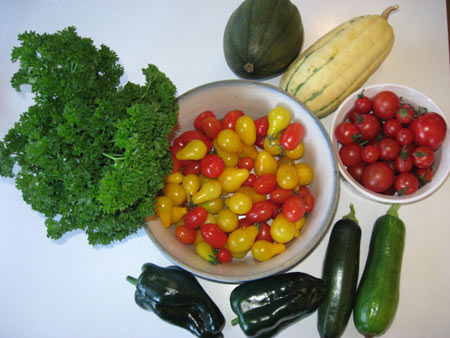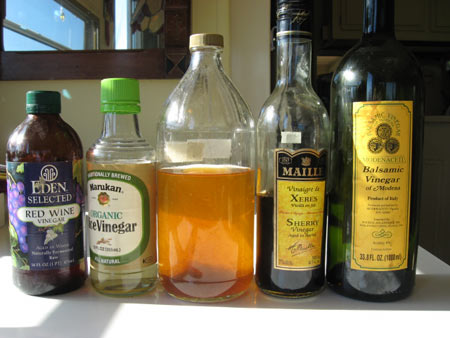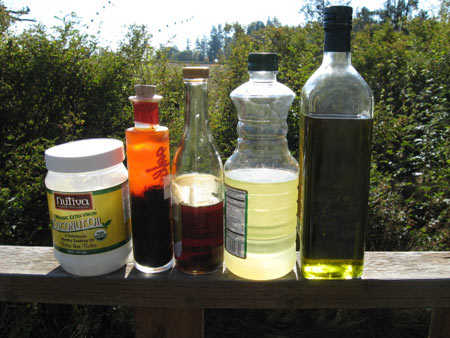This week I want to talk about my experiences with store-bought white bread. First of all, we didn’t eat it in our house when I was growing up in the 1950s. My dad said that if you ate it it would make a dough ball in your stomach and gum up your whole system. It might even cause you to explode. We ate my Mom’s home-baked white bread and the local bakery’s pumpernickel and rye swirl.
My dad died in 1959 and that changed our diets considerably. We had much less money and Ma got to make what she darn well pleased and that included more gluten-rich Austro-Hungarian fare like chicken and dumplings . . . thus began the really good Thanksgiving dressing. Actually, I think this was always her dressing, even when Dad was alive but I only remember it as a pre-teen when I started to help her make it.
Ma’s Thanksgiving Dressing
The prelude to the holiday season in my house is the smell of white bread. It’s the only time of the year that I buy the stuff because it’s my job to make Ma’s dressing for Thanksgiving. If I don’t use the real (and, paradoxically, non-real) item the family will know and I will have failed my one puny job . . . so I do it.
I start a couple of days before the event by drying out the bread.
- Buy a loaf or two of white bread (it takes about 1.5 loaves, but I cheat by using one loaf and supplementing with real bread.)
- Dry out the bread. As in, get out as much moisture as you can without toasting or burning it. This is easy for me because I have a wood stove and I put the pieces on racks on the wood stove until they’re crispy but still white.
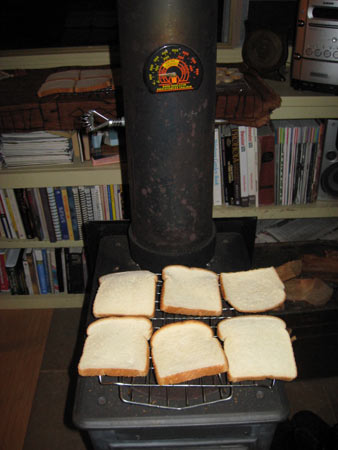
and here are my cheater breads . . . a nicely sliced baguette
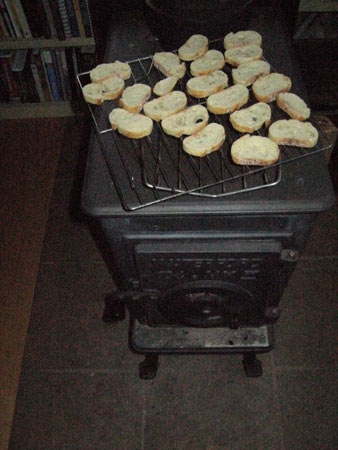
and one of my tokens to health in this recipe . . . a whole grain bread full of various seeds.
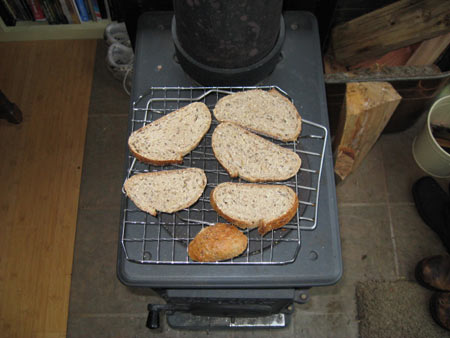
As the bread dries, crumple it into a BIG bowl and when it’s all there and the big day has arrived, get out the other ingredients: pork sausage, celery and two MAMMOTH onions (they were a over pound each).
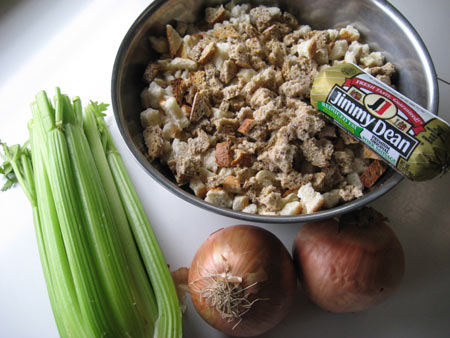
Oh . . . I forgot to tell you. A couple of days before I made the dressing I cooked up a couple of turkey backs with some water, a little salt, a small onion, quartered, and some big celery chunks. I picked off the meat, discarded the bones and skin and “defatted” the broth by putting it in the fridge and lifting off the fat that floats to the top and becomes solid with the cold (there wasn’t much). I didn’t photograph this process. It wasn’t until the next day that I decided I might blog about it. By that time the process was done. Sorry. But here are the results:
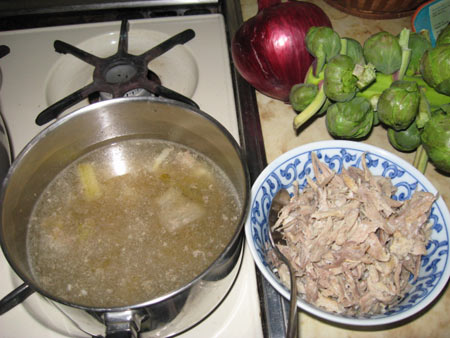
The broth, of course, is on the left. You can see big chunks of onion and celery in it. The little bits of turkey meat are on the right. My mom always used to say, “The meat’s sweeter close to the bone.” I think what she meant was that it was more flavorful, and that has been my experience.
But . . . to the process . . . and there is both nostalgia and practicality involved in this. My almost newest nephew is miles from me he will deep fry the turkey and I’m making the dressing . . . ergo WE DO NOT STUFF THE TURKEY. It’s perfectly fine if you stuff your turkey but, contrary to popular belief, you don’t have to have a turkey to make stuffing. As in, you can make the dressing off site of the main event.
Starting over again at #1) get out The Dressing Pot . . .
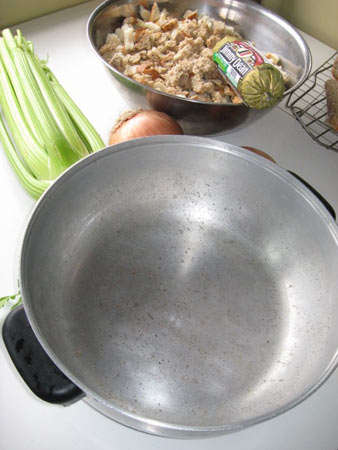
It’s aluminum. It’s the only aluminum pot I own and the only time I use it is to make dressing at Thanksgiving. It was Ma’s and she used it to make dressing . . . what can I say? It’s big, can go into the oven, and I’m a sap for tradition.
2) Put the pot on the stove, turn on the heat (mediumish) and add the pork sausage to the pot. Break it up into small pieces and stir it a lot. (I used my wood stove. It was hot-enough-to-cook-it, whatever temperature that was.)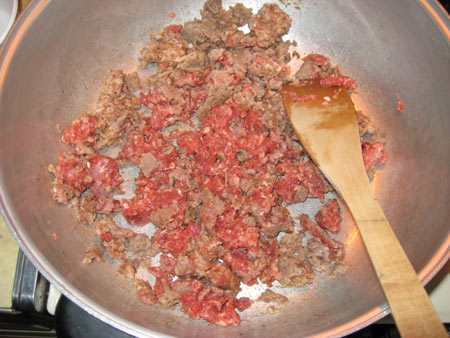
After it’s cooked through it looks like this:
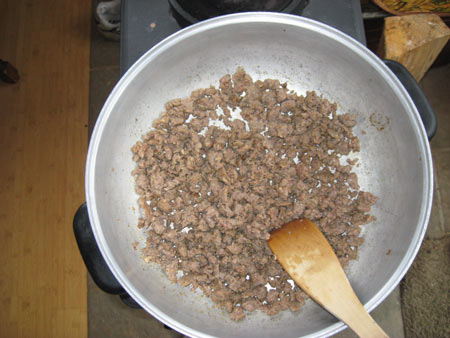
3) Add those 2 pounds or so of yellow onions that you’ve chopped up. I leave the pieces pretty big.
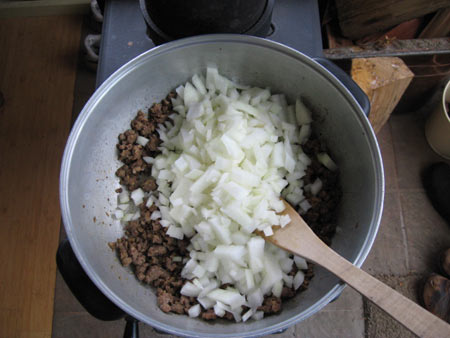
and stir them around, cooking them until they’re softened. They look a little translucent.
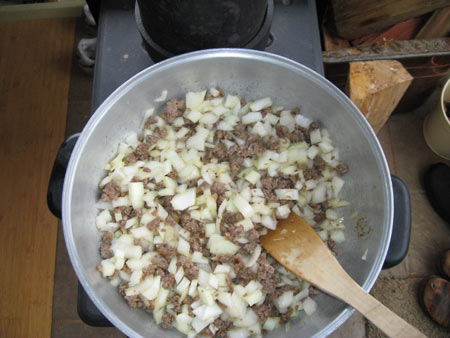
Next, I added the small turkey bits.
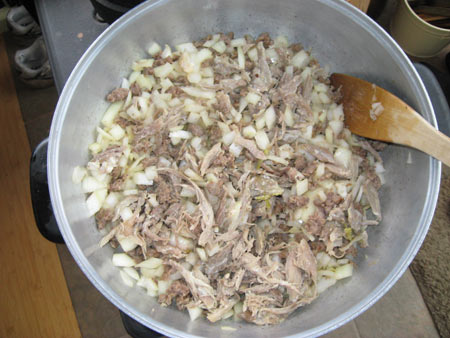
I let those warm up while I chopped some celery . . .
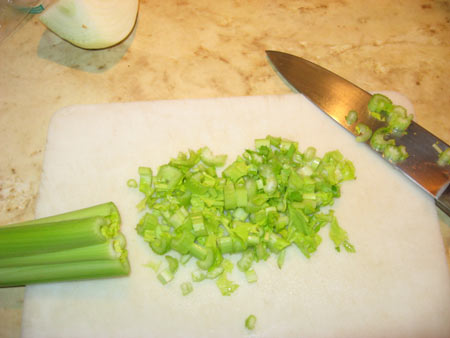
which I then added to the pot. I don’t cook it much at this point, just stir it well to distribute the ingredients evenly and then I remove the pot from the heat source.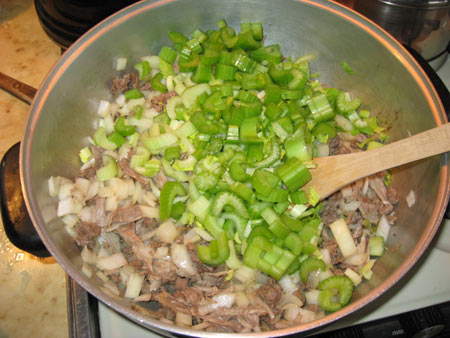
4) Next, I added the dried bread, mixed it up with the the other stuff, and poured the warm (not hot) broth over the whole shebang.
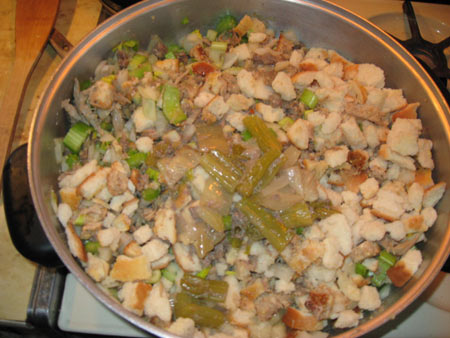
You can see the very cooked onion and celery that were in the broth. They’re soft and will disappear when you do the next step which is to mix it by hand . . . as in, you simply must put your hand in there and start kneading it together. Your broth can’t be too hot or else you’ll burn yourself.
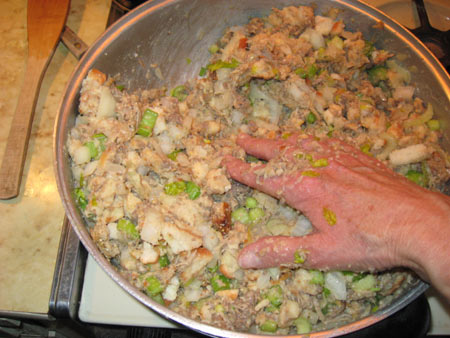
Now . . . every year, at this point in the process, I can hear Ma in my head . . . “You should do this the day before so that all the bread has a chance to absorb the moisture,” she says. And, of course, she’s right. But unlike her, I’m not always on top of the food-scheduling thing, and for the most part, my dressing is pretty good.
How much broth to add? Well, you want your dressing to be kind of gooey. It’s what Ma called “wet dressing.” It sticks together but it doesn’t have excess liquid. Therefore, I don’t add all the turkey broth at once. I add it as the bread absorbs it. It’s usually about a quart total. If you didn’t want to make your own broth you could add a quart of chicken broth. This is a good brand I get at Costco:
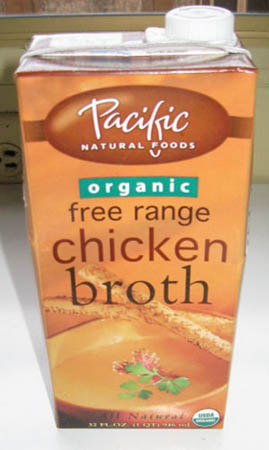 But really . . . you need those little turkey bits to make it taste like turkey dressing. If you want the real deal you need to boil up some backs or necks and pick off the meat.
But really . . . you need those little turkey bits to make it taste like turkey dressing. If you want the real deal you need to boil up some backs or necks and pick off the meat.
Also . . . salt . . . I taste the dressing as I’m squishing it together and add salt to my taste if it needs it. The breads have salt in them and I can’t be sure how much. I tend to “under salt” as I cook. People can always add what they want at the table.
Now . . . a true confession . . . I love to eat the dressing at this stage. I loved it as a kid. My mom would shudder and say, “You’re eating RAW dressing!!” but she let me do it. It’s not really raw at this point, except for the celery.
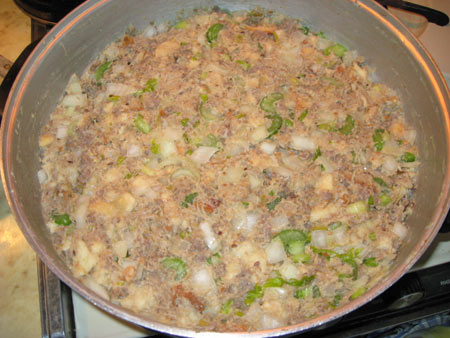
However . . . before I serve it to the family I bake it at 350º for about 1½ hours. Cover it for the first hour and bake it uncovered for the last half hour. When it’s done it looks like this . . .
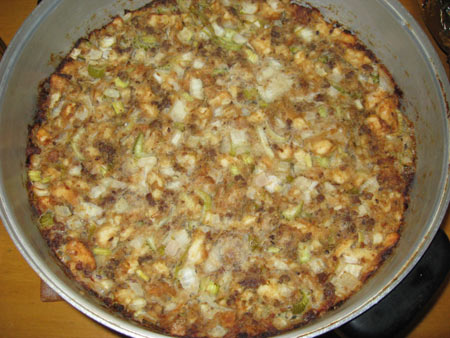
For the record? Most of my family loves the dressing more than the turkey. Me too.




















